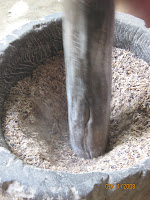If a man happens to like
a woman, he asks the help of the elders in the community then they go to the
woman’s house and the elders help convince the woman to marry him. Or the elders may ask a man whom he wants to marry and they go to that woman's house.
In the woman's house, the elders take turns in persuading the woman to accept the man for a husband. They stay for hours and would not leave until the woman accepts the man or until they are fully convinced that the woman is serious in turning him down. The elders would be drinking wine (to keep themselves
awake, too) while persuading the woman and would ask her to drink, too. If the woman accepts the glass of wine and takes a sip, it is as good as saying that she accepts the man, even if she is not aware about what it means to take a sip. So, for some mothers, they would warn their
daughters about it, especially if they know that their daughter does not want
the guy.
Some people would jokingly say that in order to make the
woman “say yes,” the elders do the kalon at night and stay until the wee hours
of the morning so that when the woman nods off to sleep in her seat, the elders
would take it to mean that the woman agrees.
As soon as the woman
says yes, the traditional marriage rites, caIled ngilin, is done right
away. Pigs and/or a water buffalo or a cow
is butchered. During the ngilin, the
elders do the bah-diw where the elders ask the spirits, the ancestors, and the
gods to bless the marriage. They also chant their advice to the couple on how to keep
their marriage.
In other communities where the ngilin is not done right
away, the elders agree on the date of marriage but they still butcher a
pig. The butchering of the pig 'seals and celebrates the deal' and I think that it also announces
to the community that the woman can’t be courted by anybody else anymore. If, days before the wedding, the woman
changes her mind, she has to pay the pig that was butchered during the day of
kalon. I am not sure though what happens
if it’s the man who backs out of the agreement.
I witnessed a kalon in the 1980’s. One time, my cousins and I were
in a relative’s wedding where we had conversations with a guy from a neighboring town. The following week or so, I saw the same guy in my cousin's house. He brought with him some elders who helped him persuade my cousin to marry him. They stayed until the wee
hours in the morning until my cousin finally consented to the betrothal. They then butchered a pig and agreed on a wedding date. My cousin was about to go abroad during that time so she
requested the guy to wait until she comes home. As of this writing, they have three kids and two grandchildren.
These days, kalon is no longer practiced, or at
least none that I’ve heard of since the 1990’s.
Young Ibaloys can now choose who to love, court, and marry. I wonder if kalon would work better at keeping marriages than love
marriages. What do you think?














